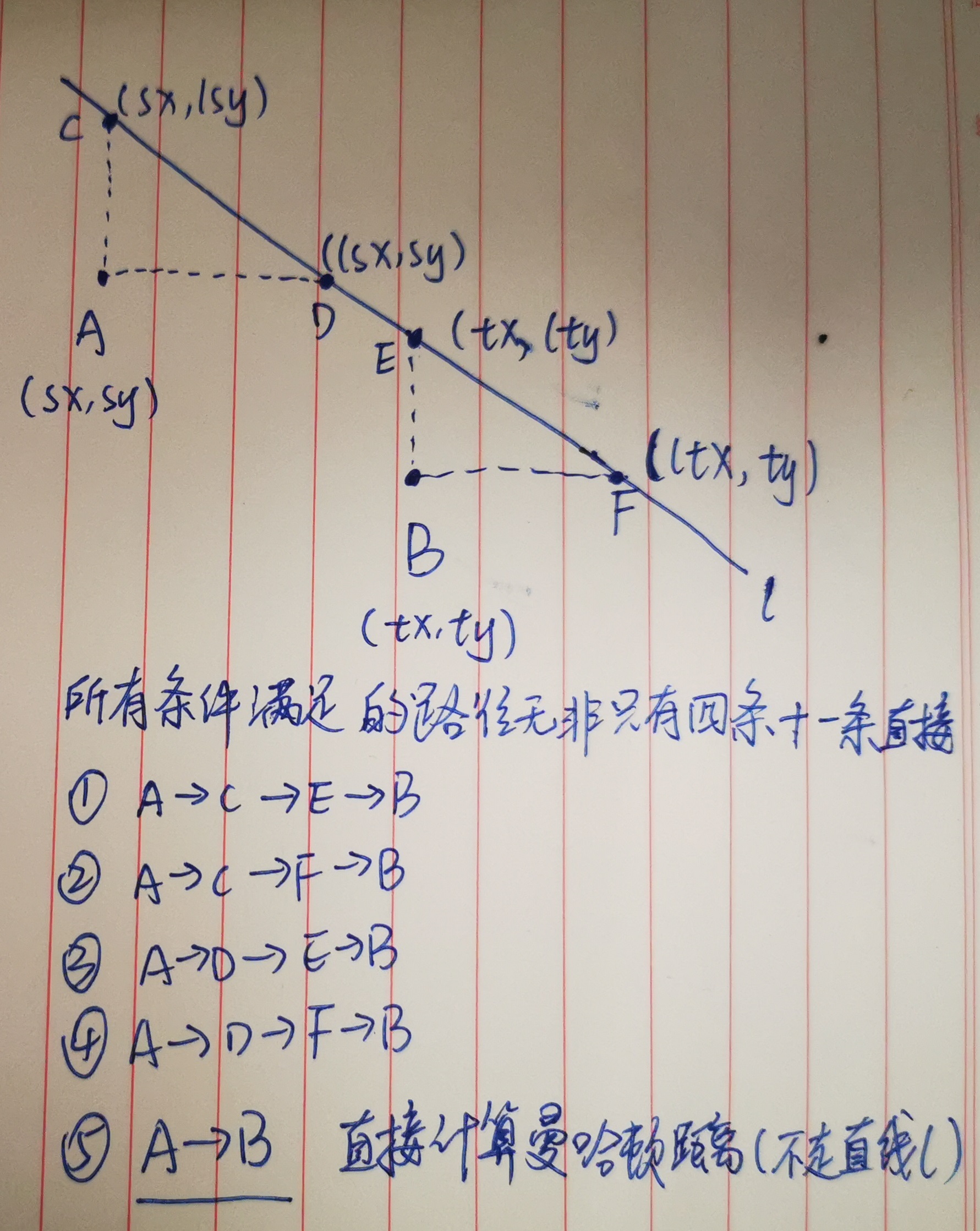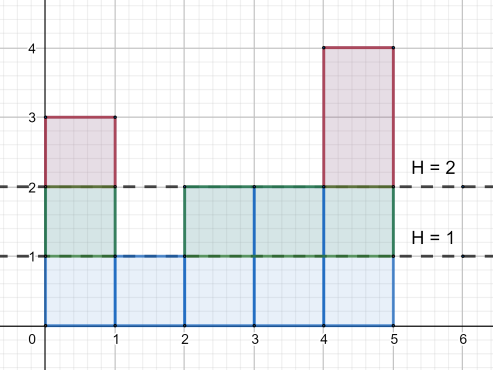A - Personalized Cup
Codeforces Round #522 (Div. 2, based on Technocup 2019 Elimination Round 3)
还没做,待补。
B - Playing Piano
Codeforces Round #522 (Div. 2, based on Technocup 2019 Elimination Round 3)
题目大意
给定一组序列a[i],求一组序列b[i],b[i]满足b[i]的数值不超过5,且如果a[i] < a[i+1]则b[i] < b[i+1],如果a[i] > a[i+1]则b[i] > b[i+1],如果a[i]=a[i+1]则b[i]!=b[i+1],如果不存在这样的b[i]序列,则输出-1。
思路
记忆化搜索。不知道不加记忆化能不能过。
代码
1
2
3
4
5
6
7
8
9
10
11
12
13
14
15
16
17
18
19
20
21
22
23
24
25
26
27
28
29
30
31
32
33
34
35
36
37
38
39
40
41
42
43
44
45
46
47
48
49
50
51
52
53
54
55
56
57
58
59
60
61
62
63
64
65
66
67
68
69
70
71
72
73
| #include< cstdio >
#include< cstring >
#include< algorithm >
using namespace std;
const int maxn=400005;
int n,a[maxn],ans[maxn],temp[maxn];
int f[maxn][6];
bool flag=false;
bool dfs(int x,int last)
{
if(flag) return true;
if(x==n+1)
{
flag=true;
for(int i=1;i<=n;i++) ans[i]=temp[i];
return true;
}
if(x==1)
{
for(int i=1;i<=5;i++)
{
if(!f[x+1][i]) continue;
temp[x]=i;
f[x+1][i]=dfs(x+1,i);
if(flag) return true;
}
}
else
{
if(a[x]>a[x-1])
{
for(int i=last+1;i<=5;i++)
{
if(!f[x+1][i]) continue;
temp[x]=i;
f[x+1][i]=dfs(x+1,i);
if(flag) return true;
}
}
else if(a[x]<a[x-1])
{
for(int i=1;i<last;i++)
{
if(!f[x+1][i]) continue;
temp[x]=i;
f[x+1][i]=dfs(x+1,i);
if(flag) return true;
}
}
else if(a[x]==a[x-1])
{
for(int i=1;i<=5;i++)
{
if(i==last) continue;
if(!f[x+1][i]) continue;
temp[x]=i;
f[x+1][i]=dfs(x+1,i);
if(flag) return true;
}
}
}
return false;
}
int main()
{
scanf("%d",&n);
for(int i=1;i<=n;i++) scanf("%d",&a[i]);
memset(f,-1,sizeof(f));
dfs(1,0);
if(!flag) return printf("-1\n"),0;
for(int i=1;i<=n;i++) printf("%d ",ans[i]);
return 0;
}
|
C - A Prank
Codeforces Round #520 (Div. 2)
题目大意
有保证递增的n个数组成的序列
a1,a2,...,an(1≤a1<a2<...<an≤1000)
现在要抹去连续的几个数,求最长能抹去多少个数,能根据剩下的数推断出原序列。
思路
显然,如果能找回来,那么删去的数的值是连续的。直接找出值连续的序列的最长长度,注意因为值是大于0小于等于1000的,所以如果最后一个数是1000或者第一个数是1,是可以删去的。
代码
1
2
3
4
5
6
7
8
9
10
11
12
13
14
15
16
17
18
19
20
21
22
23
24
| #include< cstdio >
#include< cstring >
#include< algorithm >
using namespace std;
const int maxn=100005;
int n,a[maxn],ans=0;
int main()
{
scanf("%d",&n);
for(int i=1;i<=n;i++) scanf("%d",&a[i]);
a[0]=0;a[n+1]=1001;
for(int i=1;i<=n+1;i++)
{
if(a[i]==a[i-1]+1)
{
int temp=0;
while(a[i]==a[i-1]+1) i++,temp++;
ans=max(ans,temp);
}
}
ans=max(ans,1);
printf("%d\n",ans-1);
return 0;
}
|
D - Fun with Integers
Codeforces Round #520 (Div. 2)
题目大意
给你一个正整数n,(2≤n≤100000),选一个数a,(2≤∣a∣≤n),每次再选一个整数b,(2≤∣b∣≤n),并且使得存在整数x,满足1 < ∣x∣且(a⋅x=b或b⋅x=a),a就可以转换为b,并且获得∣x∣的分数,但是之后就不能使用a转换为b或b再转换为a的操作了,求得到分数的最大值。
思路
枚举所有成k倍数的a,b,答案就是k*4的和。
为什么呢?
以一对正整数a,b (a < b)为例:
a×k=ba×(−k)=−b(−a)×k=−b(−a)×(−k)=b
答案就很显然了。
代码
1
2
3
4
5
6
7
8
9
10
11
12
13
14
15
16
17
18
19
20
| #include< cstdio >
#include< cstring >
#include< algorithm >
using namespace std;
const int maxn=200005;
int n;
long long ans=0;
int main()
{
scanf("%d",&n);
for(int i=2;i<=n;i++)
{
for(int j=2;i*j<=n;j++)
{
ans+=j*4;
}
}
printf("%lld\n",ans);
return 0;
}
|
E - Banh-mi
Codeforces Round #520 (Div. 2)
题目大意
给出一个长度为n的01串。
每次可以选择获得并删除一个位置位置上的值 x,并且会使其他位置的值加上 x 。现在给出m个询问,每个询问是一个区间[l , r] ,在这个范围内能获得的最大价值是多少。
思路
如果我们先删去值为0的位置,那么对于其他位置的贡献始终为0,显然是最差解。
所以我们每次删去所有值中最大的值,这样就能保证其他位置全部加上这个最大的值,也就保证了答案最优。
用快速幂计算等比数列即可(做这道题的时候等比数列的公式我都忘了2333)。
代码
1
2
3
4
5
6
7
8
9
10
11
12
13
14
15
16
17
18
19
20
21
22
23
24
25
26
27
28
29
30
31
32
33
34
35
36
37
38
39
40
41
42
43
| #include< cstdio >
#include< cstring >
#include< algorithm >
#define lowbit(x) (x&(-x))
using namespace std;
const int maxn=200005;
const long long mod=1e9+7;
int n,a[maxn],c[maxn],q;
void add(int x,int v) {for(int i=x;i<=n;i+=lowbit(i)) c[i]+=v;}
int get(int x) {int t=0;for(int i=x;i;i-=lowbit(i)) t+=c[i];return t;}
long long poww(long long x,long long k)
{
long long temp=1;
while(k)
{
if(k&1) temp=(temp*x)%mod;
x=(x*x)%mod;
k>>=1;
}
return temp;
}
int main()
{
scanf("%d%d",&n,&q);
for(int i=1;i<=n;i++) scanf("%1d",&a[i]);
for(int i=1;i<=n;i++) add(i,a[i]);
while(q--)
{
int l,r;
scanf("%d%d",&l,&r);
long long sum=get(r)-get(l-1);
long long zero=r-l+1-sum;
long long s=poww(2ll,zero);
long long ans=-(1-poww(2,sum));
ans=ans*s;
ans%=mod;
printf("%lld\n",ans);
}
return 0;
}
|
F - Barcelonian Distance
Codeforces Round #522 (Div. 2, based on Technocup 2019 Elimination Round 3)
题目大意
给出一条二维平面上的直线和两个点A、B,问从A点走到B点的最短路径长度。
点只能在给定直线和与坐标轴平行的直线上行走。
思路

代码
1
2
3
4
5
6
7
8
9
10
11
12
13
14
15
16
17
18
19
20
21
22
23
24
25
26
| #include< cstdio >
#include< cstring >
#include< algorithm >
#include< cmath >
using namespace std;
const int maxn=200005;
double a,b,c,sx,sy,tx,ty;
double dis(double x,double y,double xx,double yy)
{
return sqrt((xx-x)*(xx-x)+(yy-y)*(yy-y));
}
int main()
{
scanf("%lf%lf%lf%lf%lf%lf%lf",&a,&b,&c,&sx,&sy,&tx,&ty);
double lsx=-(b*sy+c)/a;
double lsy=-(a*sx+c)/b;
double ltx=-(b*ty+c)/a;
double lty=-(a*tx+c)/b;
double ans=fabs(tx-sx)+fabs(ty-sy);
ans=min(ans,fabs(lsy-sy)+dis(sx,lsy,tx,lty)+fabs(lty-ty));
ans=min(ans,fabs(lsy-sy)+dis(sx,lsy,ltx,ty)+fabs(ltx-tx));
ans=min(ans,fabs(lsx-sx)+dis(lsx,sy,tx,lty)+fabs(lty-ty));
ans=min(ans,fabs(lsx-sx)+dis(lsx,sy,ltx,ty)+fabs(ltx-tx));
printf("%.10lf\n",ans);
return 0;
}
|
G - Diverse Substring
Codeforces Round #522 (Div. 2, based on Technocup 2019 Elimination Round 3)
题目大意
国王邀请k个人来赴宴就餐,每个人都吃了好几道菜(菜的数量对每个人来说都一样),每道菜都配有一套新的厨具。每一套器具都是一样的,由不同类型的器具组成,所有种类的器皿都由1到100编号。每一类器具最多在一道菜只能出现一次。晚餐结束后,客人们都被打发走了,国王想知道能多少餐具被偷。不幸的是,国王忘记了每一位客人有多少菜,但他知道晚餐后剩下的所有餐具的清单。求出丢失餐具的最小数量。
思路
找出个数最多的餐具数量maxx,因为每个人的餐具数量是相同的,所以maxx应该能被k整除,如果不能整除,说明一定存在拿走了的情况,题目又要保证丢失餐具数量最少,所以maxx取比最初maxx大且是k的倍数的值。那么maxx*餐具种类type就是最小的总数量,再减去剩下n个餐具得到的就是被偷走的餐具数量。
代码
1
2
3
4
5
6
7
8
9
10
11
12
13
14
15
16
17
18
19
20
21
22
23
24
25
| #include< cstdio >
#include< cstring >
#include< algorithm >
#include< cmath >
using namespace std;
const int maxn=200005;
int n,k,cnt[maxn],maxx=0,types=0;
int main()
{
scanf("%d%d",&n,&k);
for(int i=1,x;i<=n;i++)
{
scanf("%d",&x);
cnt[x]++;
}
for(int i=1;i<=100;i++)
{
if(!cnt[i]) continue;
types++;
maxx=max(cnt[i],maxx);
}
while(maxx%k) maxx++;
printf("%d\n",maxx*types-n);
return 0;
}
|
H - Math
Codeforces Round #520 (Div. 2)
题目大意
输入一个数,可以对这个数进行两种操作:
- 乘以任何一个数 x
- 如果这个数为平方数(4,9,16,25…),可以对这个数开根号。
求经过若干次操作后,这个数最小能变成哪个数?并输出最少的变换次数。
思路
- 第一问:最小能变成哪个数就直接是所有质因数的乘积,这应该很好理解。
- 第二问:如果所有的质因数的个数都是2的n次方,那么显然直接开n-1次根就好了。那如果不是以上情况怎么办呢?就再乘上一个数变成那样就好了,因为没有限制乘什么数,所以乘法一步到位是合法且最优的。
代码
1
2
3
4
5
6
7
8
9
10
11
12
13
14
15
16
17
18
19
20
21
22
23
24
25
26
27
28
29
30
31
32
33
34
35
36
37
38
39
40
41
42
43
44
45
46
| #include< cstdio >
#include< cstring >
#include< algorithm >
#include< cmath >
using namespace std;
const int maxn=1000005;
int num[maxn],cnt=0,n,a[maxn],ans=1,maxx=0;
int main()
{
scanf("%d",&n);
for(int i=2;i<=n;i++)
{
if(n%i==0) num[++cnt]=i;
}
for(int i=1;i<=cnt;i++)
{
if(n&&n%num[i]==0) ans*=num[i];
while(n&&n%num[i]==0)
{
a[i]++;
n/=num[i];
maxx=max(maxx,a[i]);
}
if(!n) break;
}
printf("%d ",ans);
int tt=0;
for(int i=0;i<=30;i++)
{
if((1<<i)>=maxx)
{
tt=i;
break;
}
}
bool f=false;
for(int i=1;i<=cnt;i++)
{
if(!a[i]) continue;
if(a[i]!=(1<<tt)) f=true;
}
if(f) tt++;
printf("%d\n",tt);
return 0;
}
|
总结
一切看起来不可做的题都有巧妙的解法。










